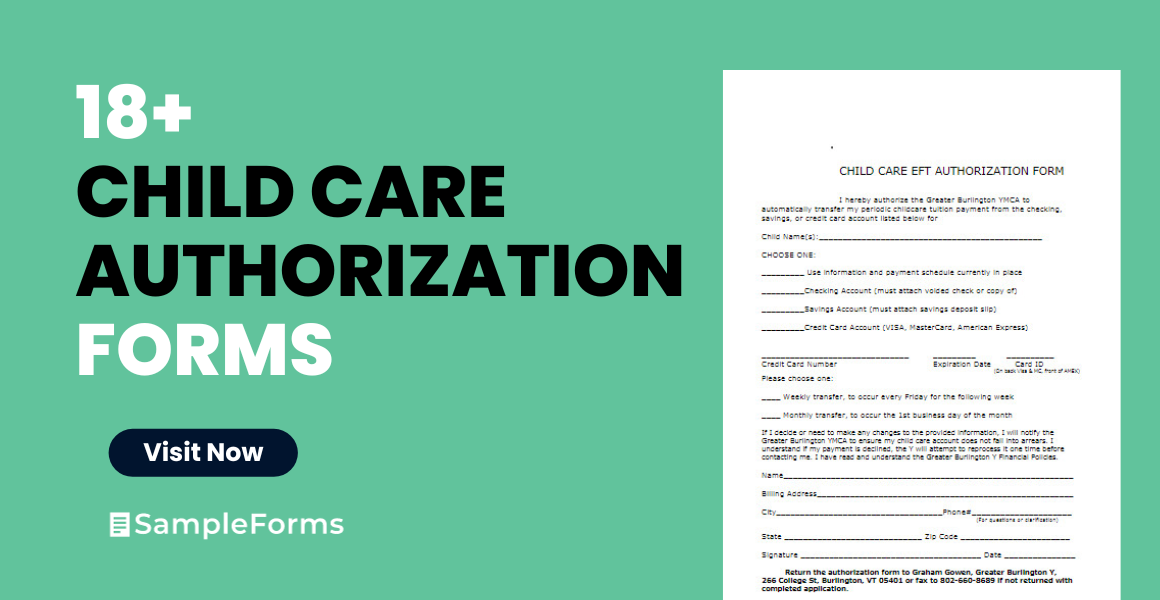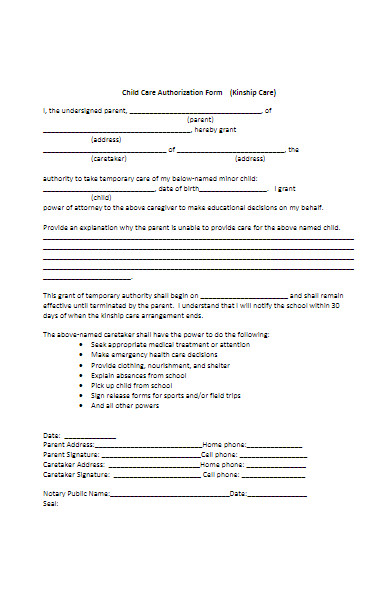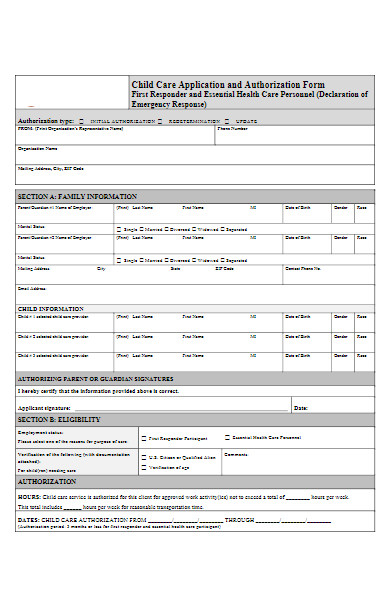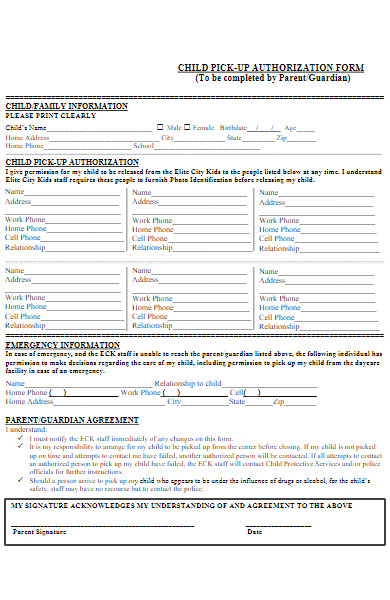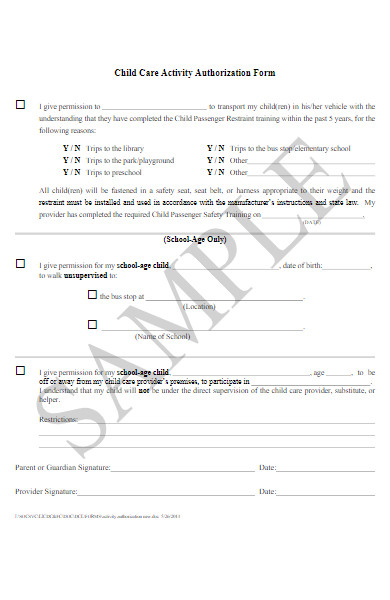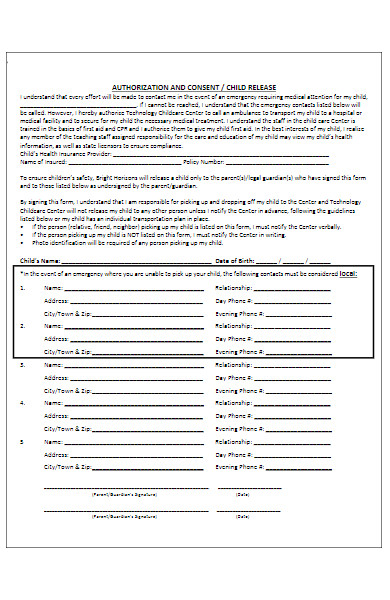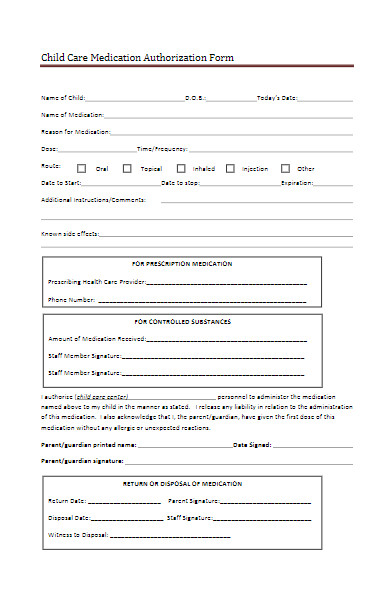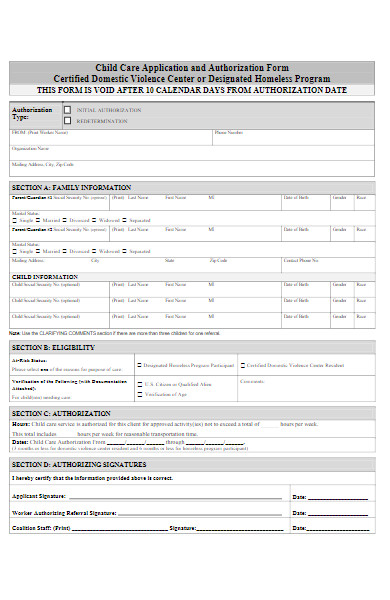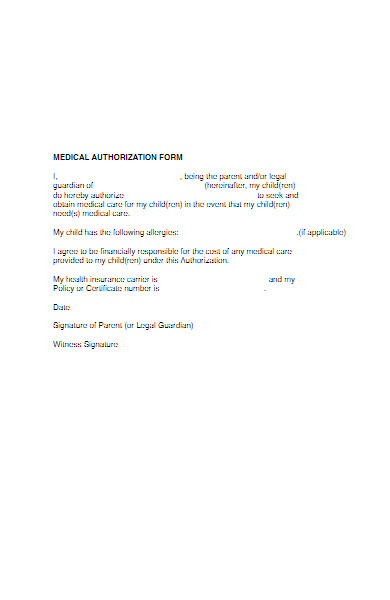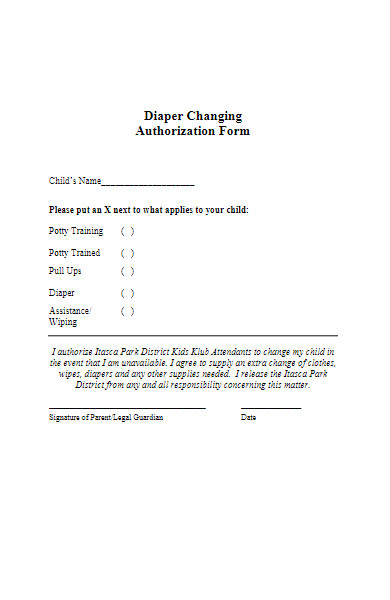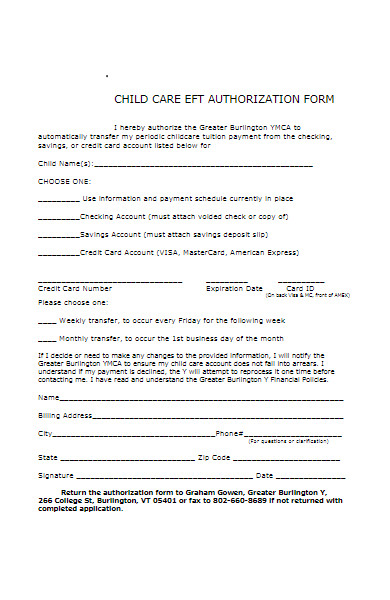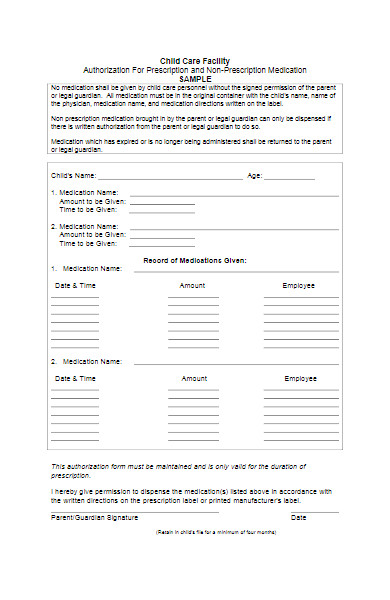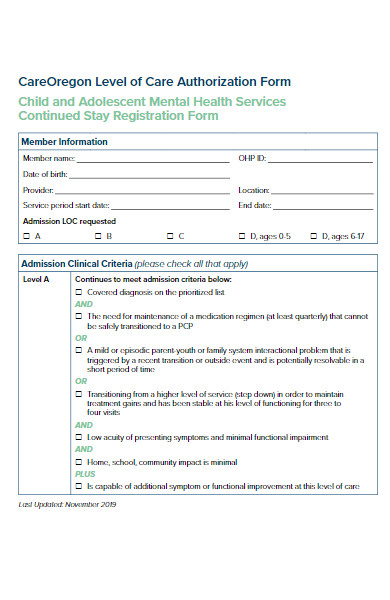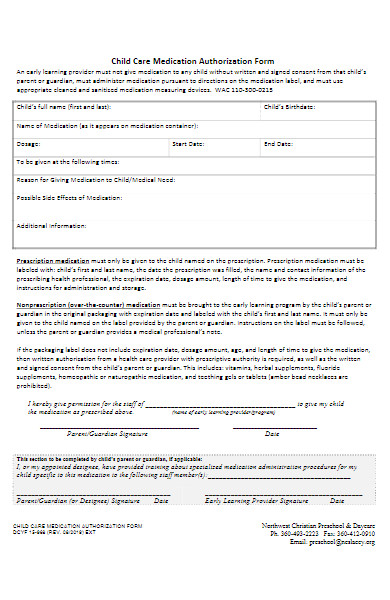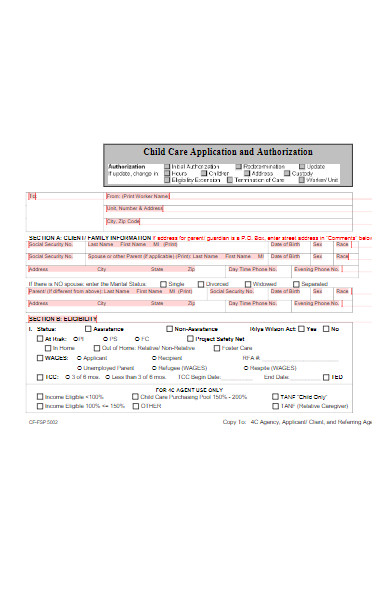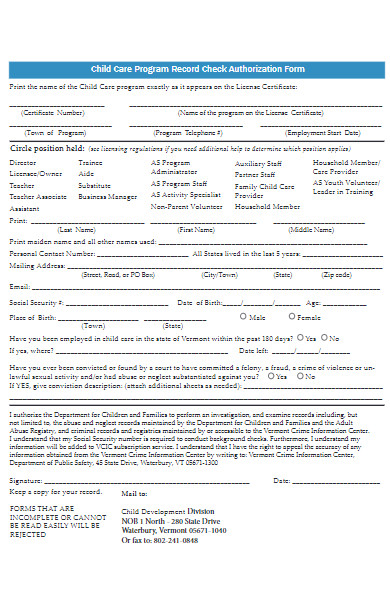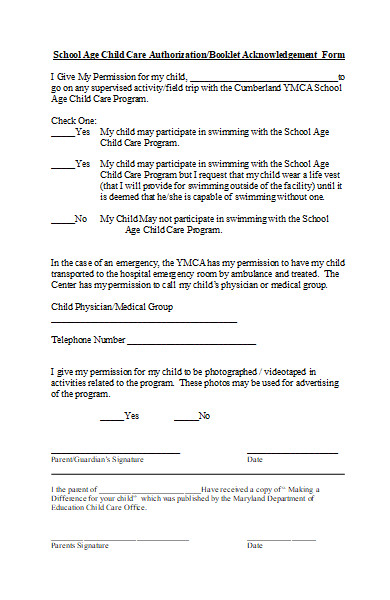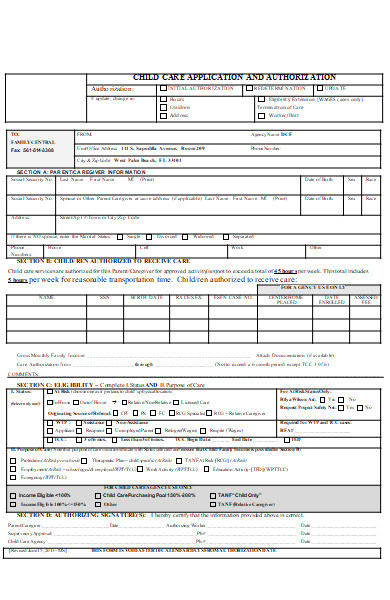A Child Care Authorization Form acts as a safety net, ensuring that children are in trusted hands when parents or guardians are unavailable. This vital document delineates permissions, helping caregivers navigate situations requiring consent. Whether it’s for daily care, a specific event, or medical emergencies, the form’s essence is to safeguard a child’s well-being. With varying types tailored to diverse scenarios, crafting a comprehensive form is essential. Dive into its significance, variants, exemplars, creation process, and expert recommendations to make it robust.
What is a Child Care Authorization Form ? – Definition
A Child Care Authorization Form is a written document that grants permission from parents or legal guardians to another individual, typically a caregiver, teacher, or relative, to take care of their child for a specified period or under certain conditions. These printable form may also empower the authorized individual to make certain decisions on behalf of the child, such as medical decisions during emergencies. By providing clear directives, the form ensures the child’s safety and well-being in the absence of their primary guardians.
What is the Meaning of a Child Care Authorization Form?
The meaning of a Child Care Authorization Form lies in its purpose and function. It serves as a formal declaration by parents or legal guardians, entrusting a designated individual with the responsibility and authority to care for their child during specified times or under particular circumstances. The form not only addresses routine care but can also encompass permissions related to medical decisions, educational matters, or other activities in the child’s interest. Essentially, it safeguards the child’s well-being by ensuring that, in the absence of primary caregivers, there’s a clear directive about who is in charge and what actions they’re authorized to take.
What is the Best Sample Child Care Authorization Form?
A best sample of a Child Care Authorization Form would be dependent on the specific needs and circumstances of the child and the caregivers. However, here’s a generic template to give you an idea:
CHILD CARE AUTHORIZATION FORM
I/We, [Parent/Guardian Full Name(s)], authorize [Authorized Person’s Full Name], of [Authorized Person’s Address], to act as a temporary caregiver for my/our child(ren):
Child’s Full Name: ____________________ Date of Birth: ________
Duration of Authorization: From [Start Date] to [End Date]
Special Instructions (if any): ________________________________________________
MEDICAL AUTHORIZATION:
In the event of a medical emergency, I/we authorize the caregiver to seek medical attention for the child(ren) and make decisions regarding their health and safety.
Doctor’s Name: ____________________ Phone: ______________
Preferred Hospital/Clinic: ____________________________________
Allergies or Medical Conditions: ______________________________
Medications: ________________________________________________
OTHER AUTHORIZATIONS:
[ ] Pick up from school [ ] Attend specific activities (e.g., field trips, classes) [ ] Others: _______________________________________
LIMITATIONS (if any):
EMERGENCY CONTACTS:
- Name: ____________________ Relationship: ________ Phone: ______________
- Name: ____________________ Relationship: ________ Phone: ______________
Parent/Guardian Signature: ____________________ Date: ________
Second Parent/Guardian Signature (if applicable): ____________________ Date: ________
Remember, this is a basic prior authorization form template. Depending on specific needs and legal requirements in different regions, additional sections or adjustments might be necessary. Always consult with legal counsel or professionals when creating such forms to ensure compliance and completeness.
FREE 18+ Child Care Authorization Forms
19. Child Care Consent Authorization Release Form
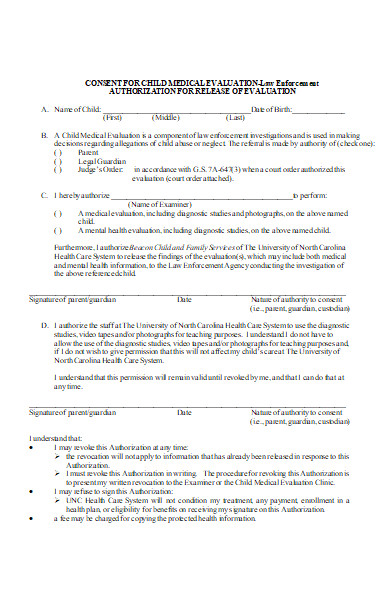
How do I fill out a Child Care Authorization Form correctly?
Filling out a Child Care Authorization Form correctly is vital to ensure that the caregiver has the right information and authority to care for the child in the absence of the parents or guardians. Here’s a step-by-step guide to help you:
-
Personal Details:
- Start by clearly writing the full names of the parents or guardians granting the authorization.
- Detail the full name, birth date, and other relevant personal information of the child(ren) involved.
-
Authorized Caregiver:
- Clearly state the full name of the person you’re authorizing to care for your child(ren).
- Optionally, provide their address and contact details.
-
Duration of Authorization:
- Specify the start and end dates for which the authorization is valid. This ensures clarity about the period the caregiver is responsible for the child.
-
Special Instructions:
- List any particular care instructions, such as bedtime routines, dietary restrictions, or specific activities the child should or should not partake in.
-
Medical Authorization:
- Mention the child’s primary care physician and their contact details.
- Specify any allergies, medical conditions, or medications the child is currently taking.
- Provide details about the preferred hospital or clinic in case of emergencies.
- Clarify if the caregiver has permission to make medical decisions or just seek medical attention.
-
Other Authorizations:
- Indicate any additional permissions, such as picking up the child from school, attending specific events, or participating in certain activities.
-
Limitations:
- Clearly state any actions or decisions the caregiver is not authorized to make.
-
Emergency Contacts:
- List at least one or two emergency contacts, detailing their names, relationship to the child, and phone numbers. This provides the caregiver with additional points of contact if necessary.
-
Signatures:
- Ensure that all legal guardians or parents sign and date the form. If applicable, notarize the document for added authenticity.
-
Review:
- Before finalizing, review all details for accuracy. Make sure all necessary fields are filled out, and the information is current.
-
Provide Copies:
- Hand a copy to the authorized caregiver, and retain a copy for your records. If the child attends school or daycare, consider providing them with a copy as well.
Remember, clarity is crucial when filling out such forms. If in doubt about any section, seek guidance from a legal professional or someone who has experience with these forms.
Who needs to sign the Child Care Authorization Form?
The Child Care Authorization Form typically requires the signatures of the following individuals:
- Primary Parent/Guardian: The primary parent or guardian who is granting the authorization must sign the form to validate the permissions given to the caregiver.
- Second Parent/Guardian (if applicable): If there are two legal guardians or parents, both may need to sign, especially in situations where joint custody or equal legal rights over decisions related to the child exist. This ensures both parties are in agreement with the authorization.
- Witness (optional): Some forms might require a witness to verify the authenticity of the signature. The witness can be any neutral third party who has observed the parent or guardian sign the document.
- Notary Public (optional but recommended): For added authenticity and to legally affirm the identity of the signatories, some individuals opt to have the form notarized. This isn’t always required, but it can add a layer of security and legality to the document, especially if there’s a potential for disputes or challenges to the caregiver’s authority.
- Authorized Caregiver (optional): Some forms might include a section for the caregiver to sign, acknowledging their understanding of the responsibilities and limitations set forth in the authorization.
Always refer to local laws or guidelines to ensure that all necessary signatures are obtained. If unsure, consulting a legal professional can provide clarity.
Can I use a digital signature on my Child Care Authorization Form?
Yes, you can use a digital signature on your Child Care Authorization Form, especially if the form is being filled out and submitted electronically. However, there are a few considerations to keep in mind:
- Legality: Digital signatures are legally recognized in many jurisdictions, but it’s essential to ensure that the digital signature is considered valid in the specific region or country where the form will be used.
- Verification: Digital signatures often come with a level of verification, ensuring the authenticity of the signer. Platforms like DocuSign, Adobe Sign, and others provide secure and verifiable digital signature solutions.
- Intention: A digital signature, like a handwritten signature, represents a person’s intention to agree to the contents of a document. Ensure that the digital signing process makes the signer’s intention clear.
- Record Keeping: One advantage of digital signatures is the ease of record-keeping. Most platforms that allow for digital signatures will also store a copy of the signed document, ensuring that both parties have access to it in the future.
- Notarization: If the Child Care Authorization Form requires notarization, check local regulations about the acceptance of digitally notarized documents. Some jurisdictions have embraced online notarization, while others might still require a traditional, in-person process.
- Ease of Use: Using a digital signature can simplify the process, especially if multiple parties (e.g., both parents or guardians) need to sign, and they’re in different locations.
While digital signatures offer convenience and security, always ensure that they are used in compliance with local regulations and that all parties involved are comfortable with the digital process.
How often should I update my Child Care Authorization Form?
The frequency with which you should update your Child Care Authorization Form depends on various factors, but as a general guideline, consider updating it:
- Upon Expiry: If your authorization form has a specified start and end date, you should update or renew the form once this duration expires.
- Change in Caregiver: If there’s a change in the designated caregiver or if you wish to add or remove someone from the authorization.
- Change in Child’s Medical Information: If your child develops a new medical condition, allergy, or there’s a change in medication, update the form to provide the most current information.
- Change in Emergency Contacts: If there’s any change in your emergency contacts or their details.
- After a Significant Life Event: Events such as moving to a new location, change in marital status, or legal changes in custody arrangements may necessitate updates to the form.
- Change in Routine or Permissions: If there’s a significant change in the child’s routine or the permissions you want to grant or rescind (e.g., picking up from a new school or allowing participation in specific activities).
- Annually: Even if none of the above events occur, it’s a good practice to review and, if necessary, update the form annually to ensure all details are current and accurate.
- Upon Request: Sometimes, institutions or organizations (like schools or activity centers) might have their own requirements and may request a recent or updated form.
Regularly updating your Child Care Authorization Form in MS Word ensures that all information is accurate, which is vital for your child’s safety and well-being. It also ensures that caregivers have the most up-to-date directives and can act in the best interest of the child.
What information is mandatory on a Child Care Authorization Form?
A Child Care Authorization Form’s primary purpose is to provide another individual the permission to care for your child in your absence and to make certain decisions on your behalf. While the exact requirements for these fillable forms may vary by jurisdiction, the following information is typically considered mandatory:
-
Child’s Information:
- Full name of the child
- Date of birth
- Address
-
Parent/Guardian’s Information:
- Full name(s)
- Address
- Contact phone numbers (including emergency contact number)
-
Authorized Caregiver’s Information:
- Full name
- Relationship to the child
- Address (if necessary)
- Contact phone number
-
Duration of Authorization:
- Specific start and end dates for which the authorization is valid.
-
Specific Permissions:
- Clear statement of what the caregiver is allowed to do, such as provide general care, pick the child up from school, seek medical treatment, etc.
-
Medical Information (if applicable):
- Child’s physician’s name and contact details.
- Details of any medical conditions, allergies, and medications.
- Permission for the caregiver to seek medical treatment if necessary.
-
Signatures:
- Signature of the parent(s) or guardian(s) granting the authorization.
- Date of signature.
- Optionally, the signature of the authorized caregiver, acknowledging their understanding and acceptance of their responsibilities.
-
Emergency Contacts:
- Name and phone number of at least one or two emergency contacts other than the parent/guardian.
Additional sections might be added based on specific needs, such as special instructions for the child’s care, dietary restrictions, or bedtime routines. It’s crucial to ensure that the form is comprehensive enough to address various situations that might arise in the parent or guardian’s absence. If unsure about what to include, it might be helpful to consult a legal professional or a template for guidance.
Where can I find a template for a Child Care Authorization Form?
Finding a template for a Child Care Authorization Form is relatively straightforward, given the wealth of resources available online. Here are some options to consider:
- Legal Websites: Many legal websites offer free or premium templates for a variety of forms, including Child Care Authorization Forms. Websites such as Rocket Lawyer, LegalZoom, and Nolo might have what you’re looking for.
- Government Websites: Depending on your jurisdiction, some government websites provide standardized forms or templates for residents’ use. It’s especially worth checking if you live in a region with specific legal requirements for child care authorization.
- Template Websites: Websites that specialize in offering templates for various purposes (like Template.net or FormsBirds) often have a section dedicated to legal and authorization forms.
- Parenting Blogs or Websites: Parenting-focused websites or blogs occasionally share templates and resources that their readers might find useful, including authorization forms.
- Online Document Services: Platforms like DocuSign or Adobe Sign may offer templates as part of their service.
- Local Child Care or Parenting Organizations: If you’re involved with local parenting or child care organizations, they might have resources or can point you to where you can find standardized forms.
- Libraries: Some libraries have resources or reference sections with various legal forms, including those for child care.
- Consult with an Attorney: If you want a form that’s tailored to your specific needs or if you’re unsure about the legal requirements in your jurisdiction, consulting with an attorney might be beneficial. They can provide guidance or even draft a form for you.
Once you find a template, it’s essential to review it thoroughly and ensure it aligns with your needs and local regulations. If needed, customize it to fit your specific situation. You should also take a look at our medical authorization forms.
Can I list multiple caregivers on a Child Care Authorization Form?
Yes, you can list multiple caregivers on a Child Care Authorization Form. In fact, it’s often advisable to do so, especially if there are several trusted individuals you anticipate might need to care for or make decisions on behalf of your child in your absence.
When listing multiple caregivers, consider the following:
- Specific Permissions: Clearly outline what each caregiver is authorized to do. For example, one caregiver might be permitted to pick up your child from school, while another might have the authority to make medical decisions in an emergency.
- Overlap in Authority: Ensure you specify whether the caregivers can act independently of one another or if they need to make decisions jointly.
- Clarity: The form should be as clear as possible to avoid any confusion or potential disputes. Each caregiver’s name, relationship to the child, and contact information should be distinctly listed.
- Duration: Specify the duration for which each caregiver is authorized, especially if there are different periods or circumstances under which each individual is allowed to act.
- Limitations or Special Instructions: If there are certain limitations or special instructions associated with a particular caregiver, make sure those are clearly outlined. For instance, if a caregiver is authorized only for after-school care, specify those hours.
- Signatures: Depending on the format of your form and local regulations, you might want to have each caregiver sign the document, acknowledging their responsibilities and the extent of their authority.
- Review Periodically: Situations and relationships can change over time. Periodically review the form and update as necessary, especially if there’s a change in your relationship with any of the caregivers or if their circumstances change.
Always ensure that the form meets the legal standards and requirements of your jurisdiction. When in doubt, consult with a legal professional to ensure the form’s validity and comprehensiveness. Our medical records authorization forms is also worth a look at
How long is a Child Care Authorization Form valid?
The validity of a Child Care Authorization Form typically depends on the specifications provided within the document itself and the legal standards or requirements of the particular jurisdiction. Here are a few factors to consider:
- Specified Duration: Many Child Care Authorization Forms will have a start and end date. If specified, the form is valid only between these dates. Once the end date passes, a new form must be created and signed if continued authorization is needed.
- Open-Ended Authorization: Some forms might not have a specific end date, implying that they remain valid until rescinded by the issuing party. However, it’s generally a good practice to review and, if necessary, renew such authorizations periodically to ensure they remain relevant to the current situation.
- Event-Triggered Expiry: The form’s validity might be contingent on certain events, like the child reaching a certain age or the end of a specific school year.
- Jurisdictional Requirements: Some jurisdictions might have specific laws or regulations that dictate how long such forms can remain valid. It’s essential to be aware of and comply with any such regulations.
- Revocation: The parent or guardian who issued the form can typically revoke it at any time. If the form is revoked, it’s no longer valid, regardless of any specified end date. It’s good practice to notify all involved parties (like the caregiver and institutions like schools) in writing if the authorization is revoked.
- Special Circumstances: Some forms might specify that they are only valid under certain circumstances, such as during a parent’s out-of-country trip. In such cases, the form’s validity is contingent on those circumstances.
To ensure the safety and best interests of the child, it’s wise for parents and guardians to regularly review any Child Care Authorization Forms they have issued and make updates as necessary. If there’s any uncertainty regarding a form’s validity or if you need guidance on setting an appropriate duration, consulting with a legal professional can provide clarity. You can also check our blank authorization form.
How to Create a Child Care Authorization Form? – a Step by Step Guide
Creating a Child Care Authorization Form requires careful thought and attention to ensure it’s comprehensive and legally sound. Here’s a step-by-step guide to help you create one:
-
Header or Title:
- Start with a clear header or title, such as “Child Care Authorization Form.”
-
Child’s Information:
- Full name
- Date of birth
- Address
-
Parent/Guardian’s Information:
- Full name
- Address
- Contact phone numbers (including emergency contact number)
-
Caregiver’s Information:
- Full name
- Relationship to the child
- Address
- Contact phone number
-
Duration of Authorization:
- Specify the start and end date for which the authorization is valid.
-
Specific Permissions:
- Clearly state the permissions you’re granting the caregiver. This could include picking up the child from school, seeking medical treatment, providing food, etc.
-
Medical Information (if relevant):
- Child’s physician’s name and contact details
- Details about allergies, medications, or medical conditions
- Permission for the caregiver to seek medical treatment if necessary
-
Limitations or Special Instructions:
- Provide any specific instructions for the child’s care, like bedtime routines, dietary restrictions, activities they are/aren’t allowed to participate in, etc.
-
Emergency Contacts:
- List one or two individuals who can be contacted in an emergency, other than the parent/guardian.
-
Signatures:
- Have a space for the parent(s) or guardian(s) to sign and date the form.
- Consider having a space for the caregiver to sign, acknowledging their responsibilities and permissions.
-
Revocation Clause:
Optionally, include a clause stating that the parent/guardian can revoke the authorization at any time, requiring notification to the caregiver.
-
Notarization (if required):
Depending on local regulations or personal preference, you might want to have the form notarized to lend it additional legal weight.
-
Review & Consult:
Before finalizing the form, review it for clarity and completeness. Consider consulting a legal professional to ensure it meets all necessary legal standards.
-
Distribution:
Once the form is completed and signed, make copies. Keep one for yourself, provide one to the caregiver, and consider giving copies to relevant institutions like your child’s school or daycare.
Remember, the specifics might vary depending on your jurisdiction, personal preferences, and the particular caregiving arrangement. Always prioritize the child’s safety and best interests when creating and issuing a Child Care Authorization Form. In addition, you should review our Daycare Authorization Form.
Tips for creating an Effective Child Care Authorization Form
Creating an effective Child Care Authorization Form requires attention to detail and a focus on clarity to ensure that caregivers, institutions, and other relevant parties fully understand their permissions and responsibilities. Here are some tips to help you craft an effective form:
- Be Specific: Clearly define the scope of the authorization. For instance, instead of just saying the caregiver can seek medical attention, you might specify that they can approve over-the-counter medications or emergency treatments.
- Use Simple Language: Keep the wording straightforward and avoid legal jargon. This ensures all parties understand the form without confusion.
- Include Essential Details: Ensure you cover all necessary information about the child, such as allergies, medications, dietary requirements, or any other specific needs.
- Limit Duration: Instead of an open-ended authorization, specify a start and end date to keep the authorization period clear.
- Detail Multiple Scenarios: Consider the different situations where the caregiver might be in charge – such as after school, during vacations, or in emergencies – and provide guidance for each.
- Add Emergency Contacts: List more than one emergency contact, so there are multiple people who can be reached if necessary.
- Include a Revocation Clause: State clearly that the authorization can be revoked at any time and provide instructions on how you’ll communicate the revocation.
- Photos Can Be Helpful: Attach a recent photo of the child and possibly even the authorized caregiver. This can be especially helpful in situations like school pickups.
- Consider Notarization: Depending on the seriousness of the authorization and local regulations, having the form notarized can provide an added layer of legitimacy.
- Stay Updated: Children’s needs and routines change as they grow. Review and update the form periodically to reflect any changes.
- Consult a Legal Professional: Especially if you’re unsure or if the caregiving situation is complex, it’s wise to get legal advice to ensure the form is valid and comprehensive.
- Maintain Open Communication: Encourage the caregiver to reach out with any questions or clarifications. The more open the communication, the more effectively they can care for your child in your absence.
- Use a Template: Starting with a template can help ensure you cover all the essential points. However, always customize the template to suit your specific needs.
- Distribute Copies: After signing, provide copies of the form to relevant parties, such as schools, daycare centers, or medical facilities, and keep a copy for your records.
Remember, the primary goal of the Child Care Authorization Form is to ensure the child’s safety and well-being. Prioritize their needs and ensure everyone involved understands their roles and responsibilities.
Related Posts Here
-
FREE 13+ Check Authorization Forms in PDF | MS Word
-
FREE 9+ Sample Pre Authorization Forms in PDF | Excel
-
FREE 9+ Sample Authorization Request Forms in PDF | MS Word | Excel
-
FREE 8+ Sample Travel Authorization Forms in PDF | MS Word | Excel
-
FREE 9+ Sample Travel Authorization Forms in MS Word | PDF | Excel
-
FREE 10+ Sample Credit Authorization Forms in PDF | MS Word | Excel
-
FREE 8+ Sample Medicare Authorization Forms in PDF | MS Word
-
FREE 8+ Hotel Credit Card Authorization Forms in PDF | MS Word | Excel
-
FREE 9+ Medical Records Authorization Forms in PDF | MS Word | Excel
-
FREE 13+ Payroll Authorization Forms in PDF | MS Word | Excel
-
FREE 8+ Medical Treatment Authorization Forms in PDF | MS Word | Excel
-
FREE 10+ Sample Medical Authorization Forms in PDF | MS Word | Excel
-
FREE 7+ Recurring Credit Card Authorization Forms in PDF | MS Word
-
FREE 5+ Daycare Authorization Forms in PDF
-
FREE 10+ Compensatory Time Authorization Forms in PDF | MS Word
